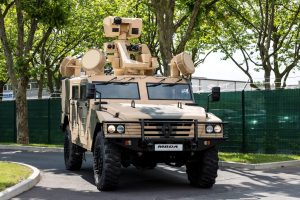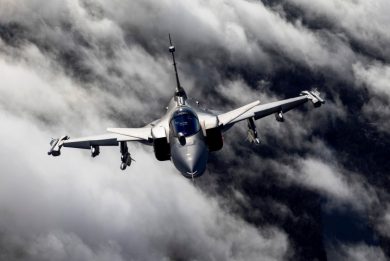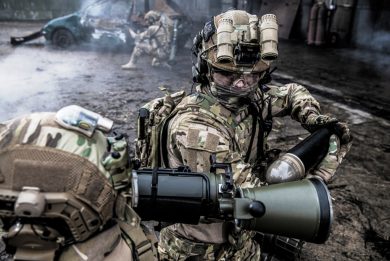
MBDA further details its Sky Warden C-UAS system
By Joseph Roukoz
With the drone threat increasing both in the civil as well as in the military domain, MBDA leveraged its know-how in air defence solutions to develop an integrated system capable to deal with Class 1 drone but not only, as it is also open to modules allowing dealing with higher level threats.
A press conference was set up to update the media on MBDA’s Sky Warden solution, first unveiled at IDEX 2021. The European missile company acts as the system integrator of Team Sky Warden, MBDA having understood very well since inception that a solution against unmanned air systems cannot be found using a single type of sensor or effector. Beside MBDA Team Sky Warden includes CerbAir, a specialist in drone detection and neutralisation, KEAS, specialised in jammers, Cilas, active in the laser domain, Teledyne e2v, specialized in RF technologies with its Safe Stop Air capable to stop a UAV at 400 meters distance of using a 1m2 antenna, Saab with its Giraffe G1X radar, and Openworks providing its SkyWall net-based system for capturing drones. As for MBDA, the company provides the Licorne command and control system, a remote electro-optical sensor, a hard kill drone which details were not unveiled, and the Mistral VSHORAD surface-to-air missile system.
Detecting the drone is the first issue, and to this end radar, electro-optic and electronic warfare sensors are used, each solution having strengths and weaknesses, using all of them allowing compensating and ensuring maximum reliability. Gathering all information and elaborating them, exploiting algorithms based on Artificial Intelligence, allows identifying the single drone, assessing the potential threat, would it be a single item or a swarm of drones.
It is now time to neutralise the threat. How to do it depends very much on the scenario, as a solution viable for a military forward operating base in the desert cannot definitely be used to cope with a threat around a football stadium, in the middle of a town.
Different options are this provided by the Sky Warden. The first one is to jam the link between the drone and the ground control station, which usually brings either the drone to land or to go back to base, in that case allowing to acquire the location of the GCS and eventually permitting to apprehend the pilot. A second option is to launch a counter-UAS drone fitted with optronic sensors that allow it to acquire the enemy drone and neutralise it with a direct hit, exploiting kinetic energy for destroying the threat. A third option is provided by a high-energy laser, which would destroy the electronic circuits of the drone.
As with the sensors, also effectors have good and bad points, depending on the type of threat and on the scenario, a direct energy weapon such as a laser can hardly be used in urban areas, thus the availability of different options should ensure an overall coverage against current threats. However the Sky Warden is modular, and as new threats might emerge, new sensors and effectors might well be integrated into the system.
While the system was designed to cope with Class 1 drones, MBDA does not exclude the ability to neutralise threats belonging to higher classes, and in that case it proposes the integration of its ground-based surface-to-air missiles, such as the Mistral VSHORAD or the MICA SHORAD systems.
As said the Sky Warden is fully modular, therefore a customer can pick-up the subsystems of choice in order to tailor the overall system to the threat he needs to face. On the MBDA site at the Plessis-Robinson, on the outskirts of Paris, it was possible to see the Sky Warden installed over a Sherpa 4×4 armoured vehicle provided by Arquus, which roof was full of subsystems, although not all those aforementioned were present.

At the corners we could find four AESA antennas, apparently MHR RPS-42 from Rada of Israel, each covering 90°, capable to detect a nano-UAS at 5 km and a medium-size UAS at 25 km range. These can be replaced by Saab Giraffe G1X radar that might also be installed on the roof, on a telescopic mast. At the centre a mast was carrying the HELMA-P middle power laser weapon from CILAS, capable to neutralise a drone at over 1,000 meters and damage its optics at 3 km. Between the two forward antennas we find a Hornet Lite remotely controlled weapon station armed with a 7.62 mm machine gun; such a weapon doesn’t fit into the C-UAS scenario, but this might indicate a possible evolution of that turret into a C-UAS system. It can also be replaced by the Openworks SkyWall net system. At the back of the vehicle we find the container/launchers of the hard-kill UAV, while the passive RF suite and the jammers were not installed. The Mistral missile system was installed on a second vehicle.
First unveiled at IDEX, aiming at the export market, the Sky Warden is the base of the system promoted by a consortium including MBDA together with Naval Groupe and Hologuarde which is competing for the PARADE French anti-drone system, a bid launched by the Direction Générale de l’Armement (DGA), the French Defence acquisition directorate being expected to announce the winning team in the first half of 2022. The programme foresees a € 350 million investment in 11 years, to counter the drone proliferation in the hexagon, a parliamentary report saying that compared to the 4 00,000 civilian drones that were flying in France in 2017, four years later that figure reached 2.5 million. One of the aims of the Parade programme is to provide an effective anti-drone system to be used during the Olympic Games 2024 that will take place in Paris and neighbouring areas.
MBDA is also involved in the European JEY-CUAS (Joint European sYstem for Countering Unmanned Aerial Systems) programme, which was selected among the many proposals as part of the European Defence Industrial Development Programme (EDIDP) 2020. With a total cost of € 15,003,473.08, the European Union proves a maximum contribution of € 13,500,000.00. The programme sees the participation of 38 European companies, MBDA being the third contributor, after Leonardo and Indra. A study and design project, the JEY-CUAS has a duration of 24 months and aims at developing a new generation modular and flexible C-UAS system which plug and play capability will allow easy reconfiguration to cope with the evolving threat.
Photos courtesy MBDA



